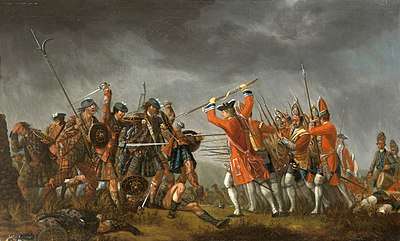Clan
A clan is a group of people united by actual or perceived kinship[1] and descent. Even if lineage details are unknown, clan members may be organized around a founding member or apical ancestor. Clans, in indigenous societies, tend to be exogamous, meaning that their members cannot marry one another. Clans preceded more centralized forms of community organization and government, and exist in every country. Members may identify with a coat of arms or other symbol to show that they are an independent clan. The kinship-based bonds may also have a symbolic ancestor, whereby the clan shares a "stipulated" common ancestor that is a symbol of the clan's unity. When this "ancestor" is non-human, it is referred to as a totem, which is frequently an animal.
| Part of a series on the | ||||||||
| Anthropology of kinship | ||||||||
|---|---|---|---|---|---|---|---|---|
 | ||||||||
|
Basic concepts
|
||||||||
|
Terminology |
||||||||
|
Case studies
|
||||||||
|
Social anthropology Cultural anthropology | ||||||||
Etymology
The English word "clan" is derived from the Scottish Gaelic clann[1] meaning "children", "offspring", "progeny" or "descendants"; it is not from the word for "family" or "clan" in either Irish[2][3] or Scottish Gaelic. According to the Oxford English Dictionary, the word "clan" was introduced into English in around 1425, as a descriptive label for the organization of society in the Scottish Highlands.[4]
None of the Irish and Scottish Gaelic terms for kinship groups is cognate to English clan; Scottish Gaelic clann means "descendants":
- fine [ˈfʲɪnʲə] means (English) "clan"
- teaghlach means "family" in the sense of the nuclear family, or can include more distant relatives living in the same house
- líon tí means either "family" in the sense of "household", or everyone who lives in the house, including non-relatives
- muintir means "family" in the broad sense of "kinsfolk"[3]
Clans as political units
In different cultures and situations, a clan usually has different meaning than other kin-based groups, such as tribes and bands. Often, the distinguishing factor is that a clan is a smaller, integral part of a larger society such as a tribe, chiefdom, or a state. In some societies, clans may have an official leader such as a chief, matriarch or patriarch; or such leadership role is performed by elders. In others, leadership positions may have to be achieved.
Examples include Irish, Scottish, Chinese, Korean, and Japanese clans, which exist as kin groups within their respective nations. Note, however, that tribes and bands can also be components of larger societies. The early Norse clans, the ætter, are often translated as "house" or "line". The Biblical tribes of Israel were composed of many clans.[5] Arab clans are sub-tribal groups within Arab society. Native American and First Nations peoples, often referred to as "tribes", also have clans. For instance, Ojibwa bands are smaller parts of the Ojibwa people or tribe in North America. The many Native American peoples are distinguished by language and culture, and most have clans and bands as the basic kinship organizations. In some cases tribes recognized each other's clans; for instance, both the Chickasaw and Choctaw tribes of the Southeast United States had fox and bear clans, who felt a kinship that reached beyond their respective tribes.
Apart from these different historical traditions of kinship, conceptual confusion arises from colloquial usages of the term. In post-Soviet countries, for example, it is quite common to speak of "clans" in reference to informal networks within the economic and political sphere. This usage reflects the assumption that their members act towards each other in a particularly close and mutually supportive way, approximating the solidarity among kinsmen. Similar usage of the term applies to specific groups of various cultures and nationalities involved in organized crime. Polish clans differ from most others as they are a collection of families who bear the same coat of arms, as opposed to claiming a common descent (see Polish heraldry). There are multiple closely related clans in the Indian subcontinent, especially South India.
Clans by continent or region

| Africa |
|
| Americas | |
| Asia | |
| South Asia |
|
| Middle East | |
| Eurasiaa | |
| Europe |
|
| Oceania |
|
a Meaning the transcontinental area between Asia and Europe.
See also
- Clan (video gaming)
- Extended family
- Uradel
- Gotra
References
- Chisholm, Hugh, ed. (1911). . Encyclopædia Britannica. 6 (11th ed.). Cambridge University Press. pp. 419–421.
- Dineen, Patrick S. (1927). Foclóir Gaeďilge agus Béarla [Dictionary of Irish and English]. Dublin and Cork, Ireland: The Educational Company of Ireland.
- Ó Dónaill, Niall (1992). Foclóir Gaeilge–Béarla [Irish–English Dictionary]. Dublin, Ireland: An Gúm. ISBN 1-85791-037-0.
- "Clan". Online Etymology Dictionary.
- See, for example, 1 Chronicles 4 and Numbers 26 in the Old Testament.